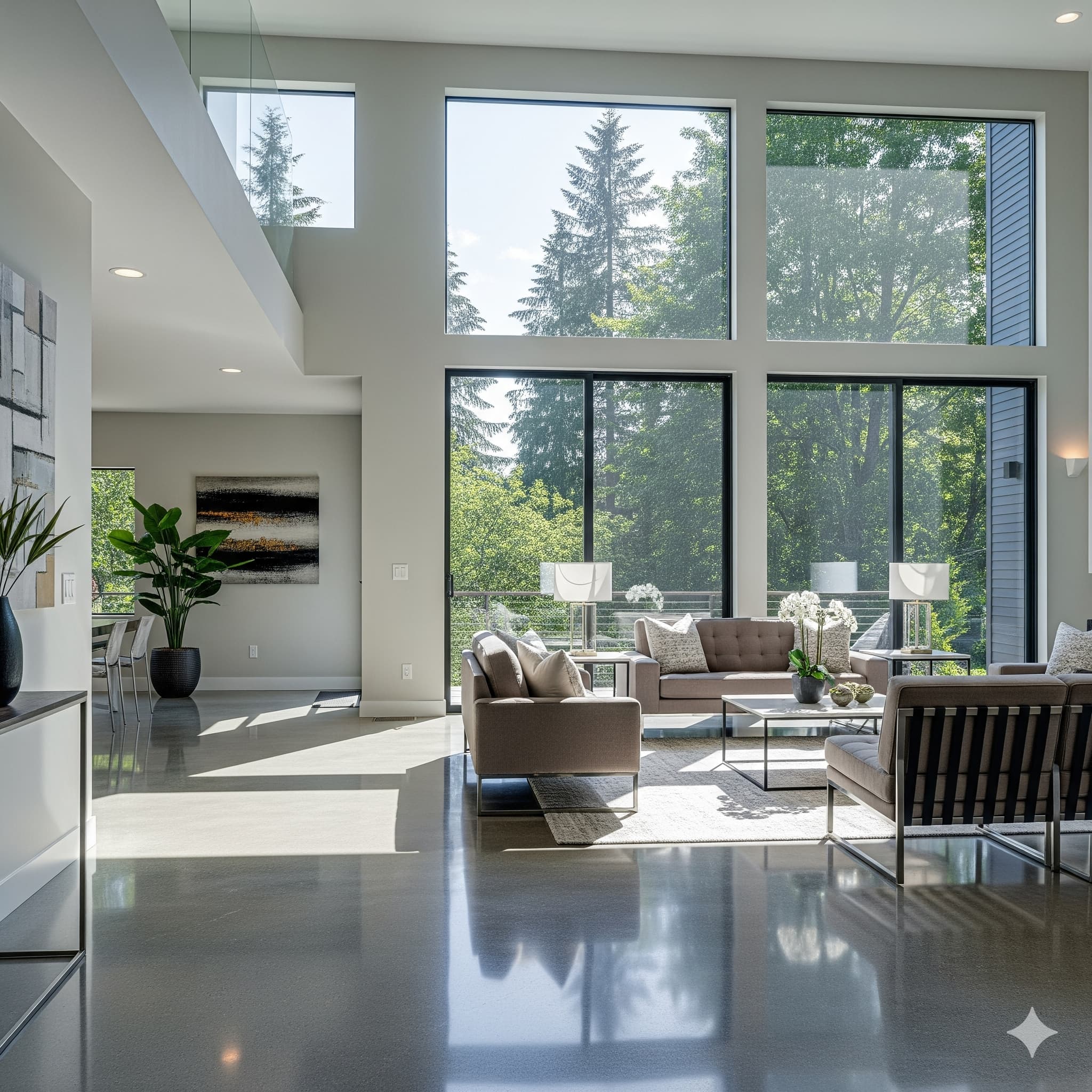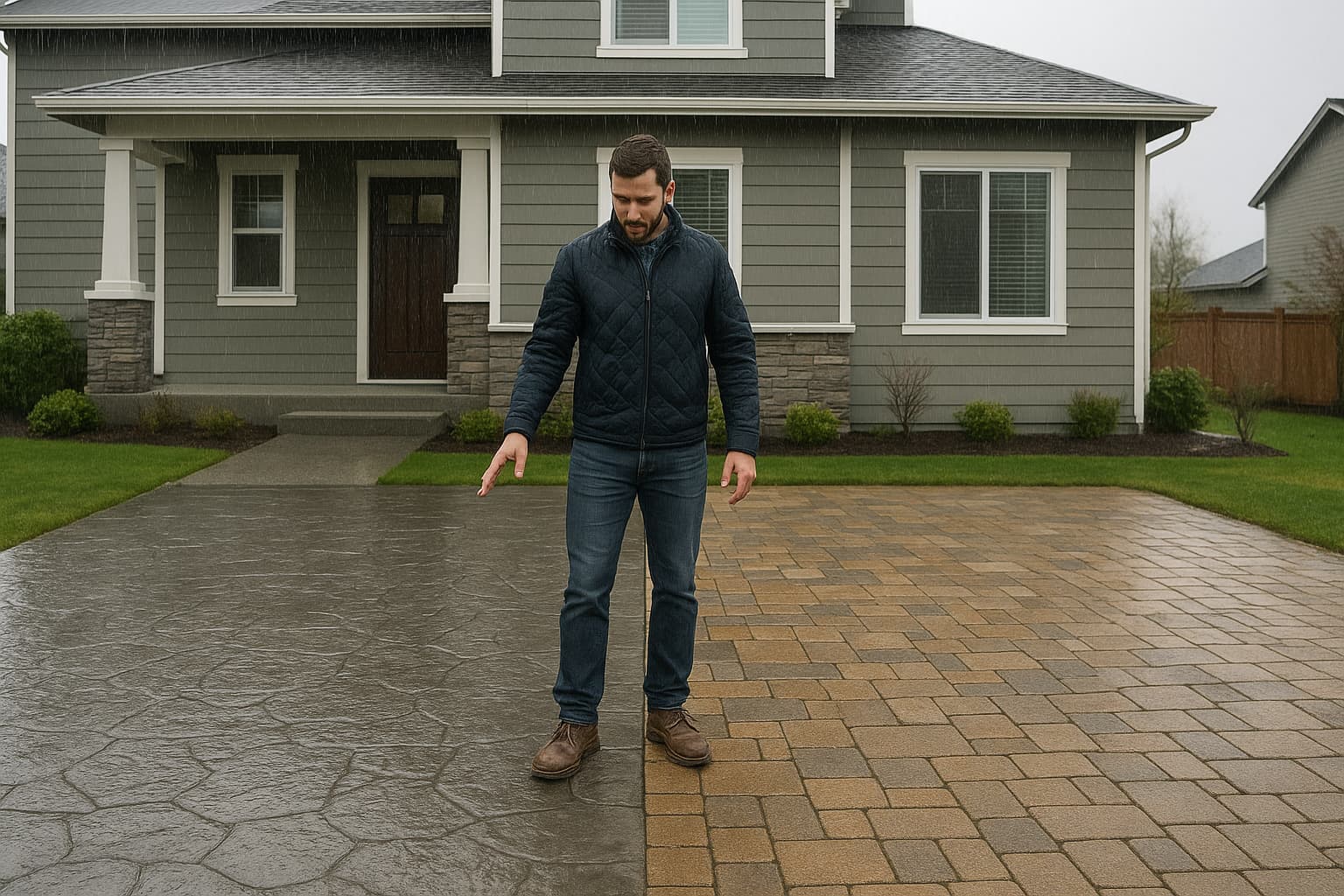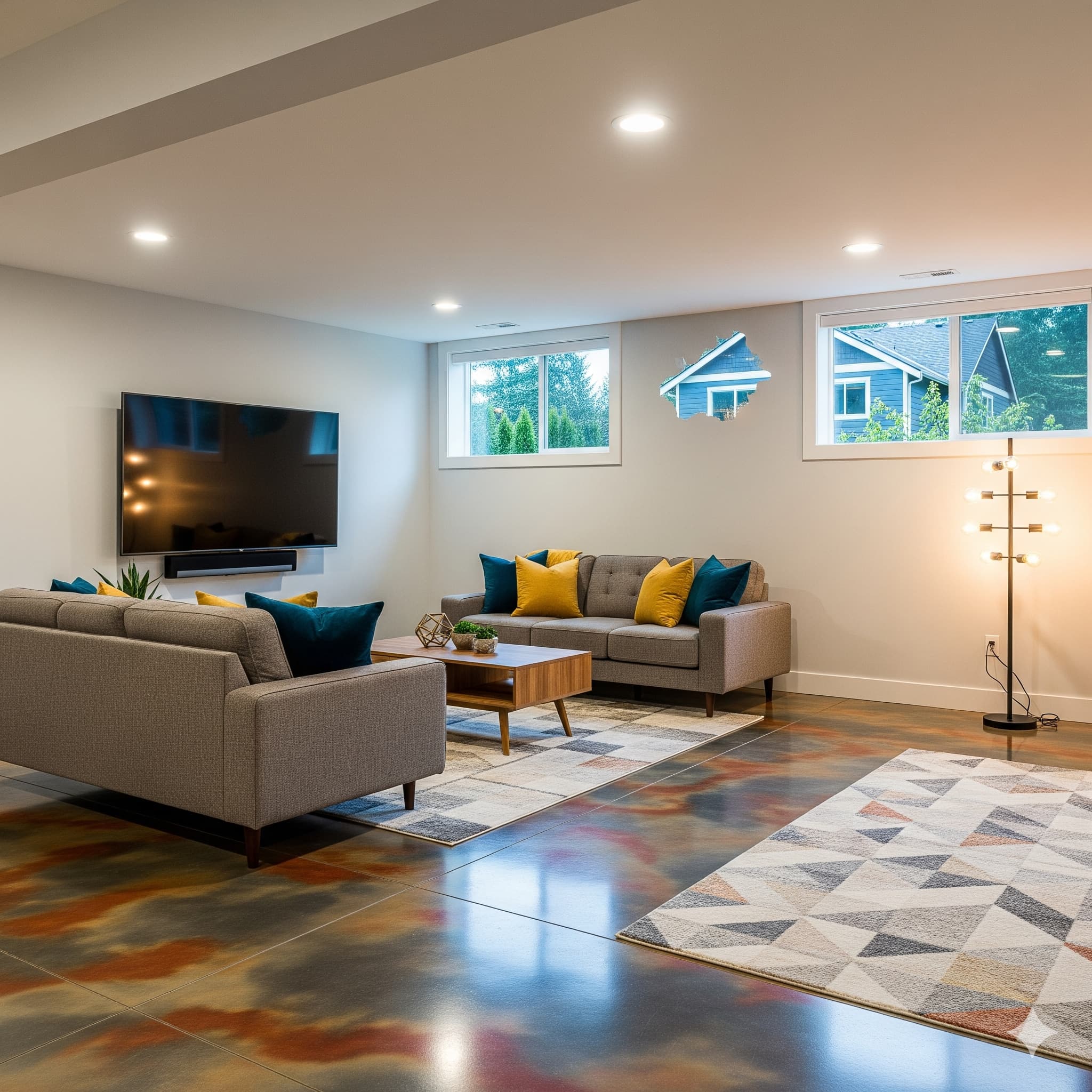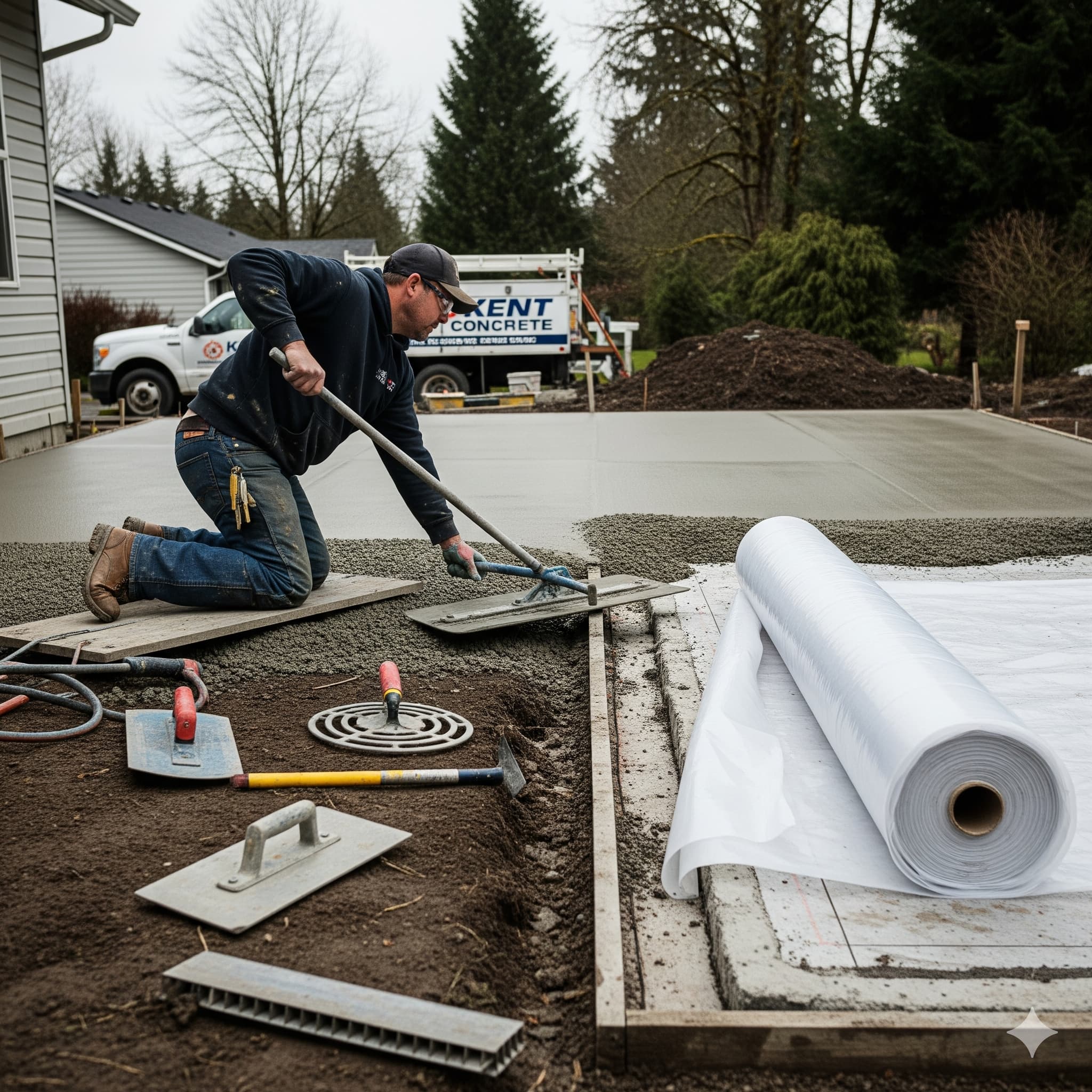
Concrete Flatwork in Wet Climates: Installation Mistakes to Avoid
Installing concrete flatwork in wet climates like the Pacific Northwest requires specialized knowledge and techniques that differ significantly from standard practices used in drier regions. Understanding common installation mistakes and proper prevention strategies ensures successful projects that withstand the challenging conditions found throughout Washington’s diverse climate zones.
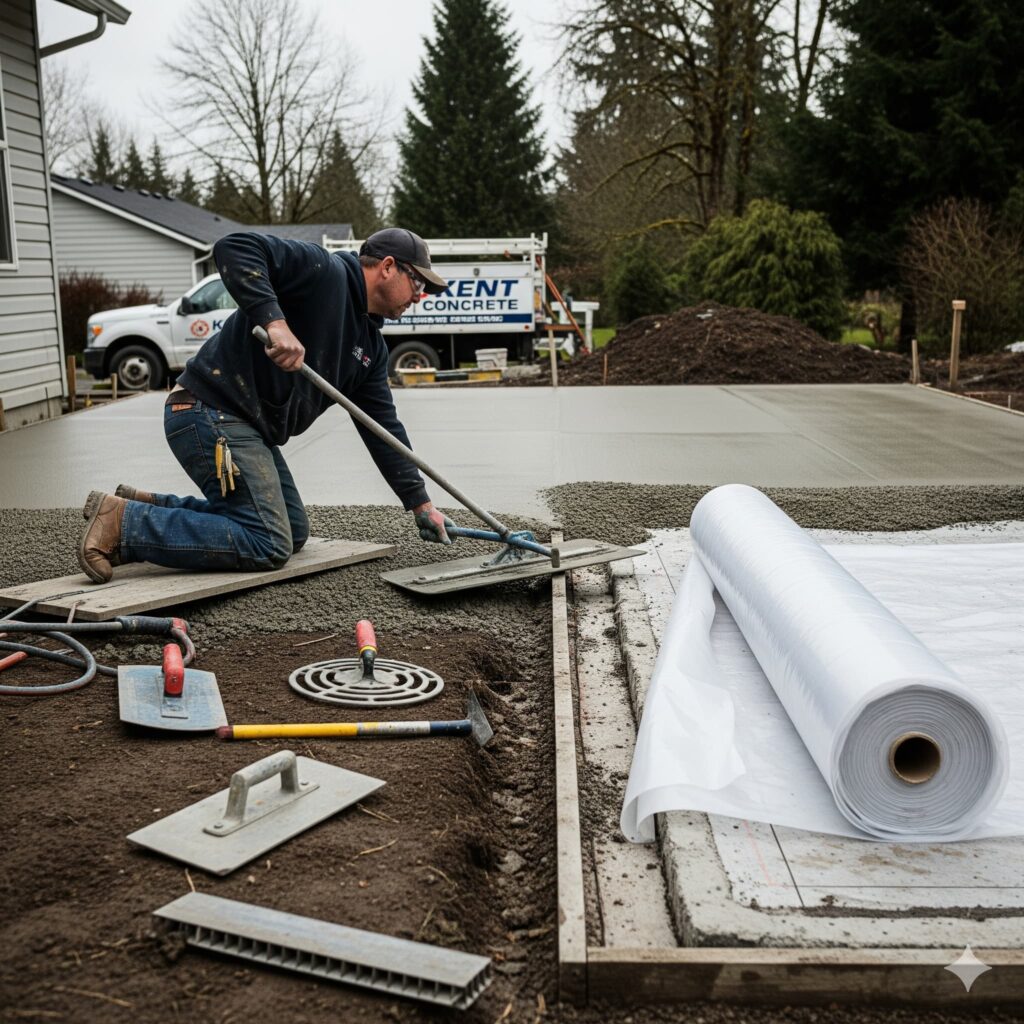
Understanding Wet Climate Challenges
Pacific Northwest conditions create unique obstacles for concrete flatwork that many contractors and homeowners underestimate. The region’s high humidity, frequent precipitation, and extended wet seasons demand modified installation approaches that account for moisture’s impact on every phase of concrete work.
Traditional concrete installation techniques developed for moderate climates often fail when applied in wet conditions without proper modifications. Moisture affects concrete mixing, placement, finishing, and curing processes in ways that can compromise long-term performance if not properly managed.
Seasonal weather patterns in areas like Kent create narrow windows for optimal concrete work, making proper planning and execution critical for project success. Understanding these limitations helps avoid rushed installations that compromise quality.
The consequences of wet climate installation mistakes often don’t appear immediately but develop over months or years as moisture-related problems manifest through cracking, scaling, or premature deterioration that requires expensive repairs or replacement.
Mistake 1: Inadequate Site Drainage Planning
Poor drainage design represents one of the most costly mistakes in wet climate concrete flatwork. Many installations fail because contractors focus on the concrete itself while neglecting comprehensive water management that prevents long-term problems.
Insufficient slope planning creates areas where water pools on or around concrete surfaces, leading to staining, freeze damage, and accelerated deterioration. Proper drainage requires minimum slopes of 1/8 inch per foot away from structures, with steeper grades often beneficial in high-rainfall areas.
Ignoring existing drainage patterns during site preparation can redirect water flow in ways that create new problems for both the concrete installation and the surrounding property. Successful projects integrate with natural drainage while enhancing overall site water management.
Failing to coordinate with landscape drainage systems creates conflicts that affect both concrete performance and landscape health. Professional installation considers all drainage elements as integrated systems rather than isolated components.
Underground drainage neglect often causes more problems than surface drainage issues. Subsurface water movement can undermine concrete flatwork through soil erosion or frost heaving that develops gradually over time.
Mistake 2: Weather Timing and Protection Errors
Attempting concrete pours during inappropriate weather conditions ranks among the most common mistakes in wet climates. Rain during placement, finishing, or early curing can permanently damage concrete surfaces and compromise structural integrity.
Inadequate weather monitoring leads to projects starting during unstable conditions, where rapid weather changes can affect concrete before protective measures can be implemented. Professional contractors use detailed weather forecasting and maintain flexibility to avoid problematic conditions.
Insufficient protection during vulnerable curing periods allows rain damage that creates surface scaling, reduced strength, and aesthetic problems. Proper protection includes tarps, temporary structures, or accelerated curing techniques that minimize weather exposure.
Seasonal timing mistakes occur when projects start late in favorable weather periods without adequate buffers for completion before conditions deteriorate. Pacific Northwest construction requires conservative scheduling that accommodates weather uncertainties.
Temperature considerations often receive inadequate attention in wet climates where moderate temperatures mask potential problems. Cold, wet conditions can significantly extend curing times and require modified mix designs or curing techniques.
Mistake 3: Moisture Control and Mix Design Problems
Using inappropriate concrete mixes for wet climate conditions creates long-term performance problems that may not become apparent until significant damage occurs. Standard mixes often lack the characteristics needed for optimal performance in high-moisture environments.
Water-cement ratio errors prove particularly problematic in wet climates where additional moisture exposure demands lower-permeability concrete. Excess water weakens concrete while increasing susceptibility to freeze-thaw damage and chemical deterioration.
Admixture selection mistakes include failing to use air entrainment, water reducers, or other additives that improve wet climate performance. These additives cost relatively little but provide significant protection against moisture-related damage.
Aggregate quality problems become more critical in wet climates where freeze-thaw resistance depends heavily on aggregate characteristics. Using absorptive or freeze-susceptible aggregates creates concrete that fails prematurely under Pacific Northwest conditions.
Curing compound application errors can trap moisture or prevent proper hydration that concrete needs for optimal strength development. Wet climates require carefully selected curing methods that balance moisture retention with surface protection.
Mistake 4: Base Preparation and Subgrade Issues
Inadequate base preparation creates problems that wet climates exacerbate through increased moisture exposure and soil movement. Proper subgrade preparation becomes more critical when dealing with expansive clays and fluctuating moisture conditions common in the Pacific Northwest.
Compaction failures allow settling that creates cracking and structural problems, particularly when combined with wet climate soil conditions that experience significant volume changes with moisture variations. Proper compaction requires specific techniques and verification procedures.
Drainage layer omission beneath concrete flatwork prevents proper moisture management that wet climates demand. Quality installations include gravel drainage layers that prevent capillary moisture rise while providing stable support.
Vapor barrier mistakes include using inappropriate materials, poor installation techniques, or omitting barriers entirely when conditions require moisture protection. Wet climates often demand more comprehensive moisture protection than standard practices provide.
Soil stabilization neglect allows base movement that wet climate conditions accelerate through freeze-thaw cycles and moisture-induced volume changes. Chemical or mechanical stabilization may be necessary for challenging soil conditions.
Mistake 5: Finishing and Curing Errors
Premature finishing operations damage concrete surfaces when high humidity or moisture conditions delay proper setting. Wet climates require patience and modified finishing techniques that account for extended setting times.
Over-finishing creates surfaces susceptible to scaling and durability problems that wet climate exposure accelerates. Proper finishing techniques minimize surface disturbance while achieving the desired texture and appearance.
Inadequate surface protection during curing allows moisture loss or gain that affects concrete strength development and durability. Wet climates require active curing management rather than relying on ambient conditions.
Joint cutting timing errors create random cracking when cuts occur too early or too late relative to concrete setting characteristics. Wet climate conditions often extend optimal cutting windows, requiring contractor flexibility and experience.
Surface sealing mistakes include using inappropriate products, incorrect application timing, or omitting protective treatments that wet climates require for long-term performance. Quality sealers provide essential protection against moisture penetration.
Mistake 6: Quality Control and Testing Oversights
Insufficient quality control during wet climate installations allows problems to develop that proper monitoring would prevent. Continuous oversight becomes more critical when weather conditions create additional variables affecting concrete performance.
Testing protocol failures include inadequate sampling, improper test specimen handling, or omitting tests that wet climate conditions make necessary. Comprehensive testing ensures concrete meets specifications despite challenging installation conditions.
Documentation mistakes prevent proper troubleshooting when problems develop and may void warranties or insurance coverage. Detailed records of conditions, procedures, and test results support long-term project success.
Inspection coordination failures allow defective work to proceed when early intervention could prevent problems. Wet climate projects benefit from increased inspection frequency during critical installation phases.
Communication breakdowns between crews, inspectors, and supervisors create confusion that leads to installation errors. Clear protocols and consistent communication prevent mistakes during weather-sensitive operations.
Prevention Strategies and Best Practices
Professional planning addresses wet climate challenges through comprehensive site assessment, weather monitoring, and contingency preparation that prevent common installation mistakes. Quality contractors understand regional conditions and plan accordingly.
Material selection specifically for wet climate performance ensures concrete mixes, admixtures, and accessories provide optimal durability and appearance despite challenging exposure conditions. Regional expertise guides appropriate material choices.
Installation timing coordination with weather patterns, crew availability, and project schedules optimizes conditions while maintaining quality standards. Successful projects balance efficiency with quality requirements.
Quality assurance protocols, including testing, inspection, and documentation, ensure installations meet specifications while providing accountability for long-term performance. Professional contractors maintain comprehensive quality control programs.
Professional Installation Advantages
Kent Concrete Masters provides specialized expertise in wet climate concrete flatwork that prevents common installation mistakes while optimizing performance for Pacific Northwest conditions. Regional experience guides proper techniques and material selection.
Comprehensive planning services address all aspects of wet climate installations, including drainage design, weather coordination, and quality control procedures that ensure project success despite challenging conditions.
Quality control programs include testing, inspection, and documentation procedures that support long-term performance while providing warranty protection for homeowner investments in concrete flatwork.
Long-term support includes maintenance guidance, repair services, and performance monitoring that protects concrete investments throughout their service lives in challenging Pacific Northwest conditions.
Successful concrete flatwork in wet climates requires understanding and avoiding common installation mistakes while implementing proven techniques that address regional challenges. Professional expertise ensures optimal results that provide decades of reliable performance despite the Pacific Northwest’s demanding environmental conditions.

